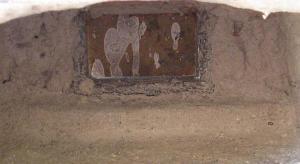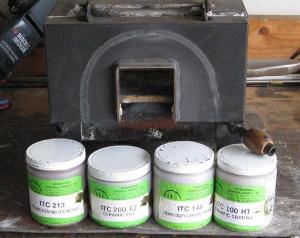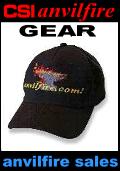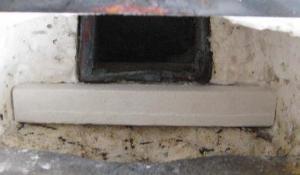Next, I added just a small amount of water and mixed about 1/2 pint of the ITC-200 until I had it the consistency of stiff bread dough.
I then applied the ITC-200 onto the step and forced it into the joints around the board.
I continued to smooth it onto the hearth and under the board.
I paid special attention to getting the ITC 200 into the joints between the walls and the hearth.
I then covered the step block and smoothed it over. I finished by building a smooth ramp up from the floor to the edge of the brick at the front of the forge. This will let me brush the scale out without having to break out the vacuum cleaner. See Photo 4.

Next, I decided to try applying some protection to the metal door frame and door flap with some ITC 213 ceramic coating for metal (Photo 5).
I wire brushed the surfaces to remove rust and scale.
When it was as clean as it was going to get, I mixed about 2 tablespoons of ITC-213 with a tablespoon of water and mixed it up to a fluid slurry.
I used a sponge brush to apply it inside and outside of the back door to the forge.
I decided to let the refractory patch dry slowly before firing it in place.
As I suspected, I mixed the ITC-200 a little wet and it showed cracks after a few hours of drying.
This was easily fixed with another application of the ITC-200 into the cracks prior to firing.
I discovered that while the material in the top of the jar was a bit dry, the material under the surface in the jar was the perfect consistency to ram into place.
It patched the cracks easily.
The directions say to hard fire the ITC-200 before coating it with ITC-100 so I will coat the entire inside of the forge after drying and firing.

After high firing the hearth patch, I allowed the forge to cool for a week since I still have a regular job to pay for my hobbies.
The next weekend I dampened the entire inside of the forge with water and then brushed on a coating of ITC 100 (Photo 6).
I let it dry for an hour and then low fired the forge until no more steam was evolving.
I then went to high fire (Photo 7) I noticed my burner was very irregular while the refractories were drying, however, it settled down just fine when everything was dry and hard fired.
So what did we gain by patching and coating with the ITC products?
As soon as the refractory coating was dry, I noticed the efficiency of the forge was noticeably improved.
It did not get hotter, but it got hot faster.
Photo 7 shows a small patch knife I was forging while the coating dried.
Even though the forge had not been running more than about 10 minutes, the blade reached forging temperature in less than 45 seconds from putting it in the forge. Yes, it is thin and a thicker piece will take longer but I expect reduced gas consumption, less oxidation and scale, and more uniform heating from my "new" forge.
As the forge continued to run the heat became more uniform although the hearth under the flame will always be hotter.

There is good engineering behind my observations.
Radiant heating is the primary mode of heat transfer in the forge, with convection heating second.
This means that the radiant heat of the incandescent gas flame is being reflected off of the refractories back into the work piece.
The hot gasses, which have lost some of their heat as they swirl in the forge, also help transfer heat to the piece by convection.
However, this is considerably less than the radiation heat from the refractories.
It only makes sense to enhance the efficiency of the most important heat transfer mechanism in the forge.
Whatever is in ITC-100, it does improve the radiation heat transfer.
The one question I cannot yet answer is how long the patch and the coating last.
I will file updates on this report whenever there is a change in my forge conditions.
I can honestly say I am very pleased with the effects of the ITC products.
However, I suggest you coat your forge NOW rather than waiting for eight years as I did!

NC Forge with ITC products, ITC-100HT, ITC-200EZ, ITC-213, ITC-296A.
See also:



 The Repair of an NC Whisper Baby Forge using ITC Products
The Repair of an NC Whisper Baby Forge using ITC Products
 To address this problem, I cut a piece of refractory board left over from another project into a 1" x 1" x 7.5" piece.
I then cut the soft refractory off of the back wall using a sharp wood chisel and a razor knife.
I cut a 1" wide x 1/2" deep groove the full width of the forge right under the door.
I then mixed up the ITC-100 as the instructions called for and coated the groove and the chunk of board.
Photo 3 shows the board pressed into the groove prior to coating.
To address this problem, I cut a piece of refractory board left over from another project into a 1" x 1" x 7.5" piece.
I then cut the soft refractory off of the back wall using a sharp wood chisel and a razor knife.
I cut a 1" wide x 1/2" deep groove the full width of the forge right under the door.
I then mixed up the ITC-100 as the instructions called for and coated the groove and the chunk of board.
Photo 3 shows the board pressed into the groove prior to coating.
 Next, I decided to try applying some protection to the metal door frame and door flap with some ITC 213 ceramic coating for metal (Photo 5).
I wire brushed the surfaces to remove rust and scale.
When it was as clean as it was going to get, I mixed about 2 tablespoons of ITC-213 with a tablespoon of water and mixed it up to a fluid slurry.
I used a sponge brush to apply it inside and outside of the back door to the forge.
Next, I decided to try applying some protection to the metal door frame and door flap with some ITC 213 ceramic coating for metal (Photo 5).
I wire brushed the surfaces to remove rust and scale.
When it was as clean as it was going to get, I mixed about 2 tablespoons of ITC-213 with a tablespoon of water and mixed it up to a fluid slurry.
I used a sponge brush to apply it inside and outside of the back door to the forge.
 After high firing the hearth patch, I allowed the forge to cool for a week since I still have a regular job to pay for my hobbies.
The next weekend I dampened the entire inside of the forge with water and then brushed on a coating of ITC 100 (Photo 6).
I let it dry for an hour and then low fired the forge until no more steam was evolving.
I then went to high fire (Photo 7) I noticed my burner was very irregular while the refractories were drying, however, it settled down just fine when everything was dry and hard fired.
After high firing the hearth patch, I allowed the forge to cool for a week since I still have a regular job to pay for my hobbies.
The next weekend I dampened the entire inside of the forge with water and then brushed on a coating of ITC 100 (Photo 6).
I let it dry for an hour and then low fired the forge until no more steam was evolving.
I then went to high fire (Photo 7) I noticed my burner was very irregular while the refractories were drying, however, it settled down just fine when everything was dry and hard fired.



By Robert Nichols AKA quenchcrack
I have run my NC Whisper Baby forge for about 8 years, but not every day. Being a Hobby Smith, most of the use was on weekends for a few hours. Nevertheless, I failed to brush out the accumulated scale and over the years, the scale fused into a thick layer on the hearth brick. It penetrated the brick and with many expansions and contractions, it crumbled the hearth brick badly. I finally noticed how bad the situation was when I used a whole 20# propane bottle in about 6 hours and the steel was still not getting hot enough to forge easily. The function of refractories is not so much to insulate the inside of the forge but to reflect the radiant heat of the burner into the work piece. A big blob of scale on the hearth does not reflect the heat efficiently.
There are two options to fix this problem. NC Tool sells a complete reline kit for $105 plus about $10 in shipping. The alternative is to patch the hearth with ITC products. The ITC products are about $40 per pint of the ITC-100HT and the ITC-200EZ for a total of about $80. The advantages of using the ITC products are:
- There is enough in a pint of the ITC products to repair 2-3 small forges or 1-2 larger ones.
- The re-line kit from NC does not include ITC-100 refractory coating that so dramatically improves the performance of the forge.
- The repair job does not require the labor intensive dismantling and resassembly of a reline.
- Buying supplies from the anvilfire Store supports our favorite web site!
The use of the ITC products was clearly more cost effective.After receiving my shipment of ITC products from the anvilfire Store, I began the repair job. The first order of business was to put on a dust mask and eye protection. I used a pair of goggles that sealed around my eyes. Remember that one of the advantages of ITC-100 coating is that it cements all the fibers in your soft refractory in place. You should have much less toxic fiber dust blowing out of your forge after coating with ITC-100.
Photo 1 shows the inside of my forge with most of the scale puddle still intact. Some of it has already broken away. It was a simple job to chip out the rest with a cold chisel. No hammer was needed. After breaking out the scale, I vacuumed out the forge to remove dust and debris.
Forge cleaned, note damage to door frame at top.
One of the design faults of the Whisper Baby is the position of the rear door. There is 1" band of soft refractory under the opening. When you put a piece into the forge, you usually poke the back wall right under the opening. This eventually erodes a groove under the door and allows hot gas to attack the door frame. You can see in Photo 2 how the door frame is being eroded away.